Abstract
Air pollutants, NO, NO2, and O3, were examined from April to June 2020 and compared to a 10-year (2010–2019) climatology of these pollutants for two monitoring sites in Toronto, Ontario, Canada, coinciding with local lockdown measures during the first wave of the COVID-19 pandemic. NO and NO2 values were lower than any of the preceding 10 years at the two Toronto sites for both weekdays and weekends. Ozone concentrations did not have a corresponding decrease and in fact increased for weekdays, similar to other parts of the world. The well-documented ozone weekend effect was considerably muted during the morning rush hour throughout this pandemic period. A Fisher exact test on hourly averaged data revealed statistically significant record hourly minimums for NO and NO2, but this was not found for ozone, consistent with the aggregate ranking results. These findings are likely the result of considerably reduced vehicular traffic during this time and ozone chemistry in a NOx-saturated (VOC limited) environment. This has important implications for ozone abatement strategies.
1. Introduction
Human cases of the novel corona virus were first detected in December of 2019 in Wuhan, China. At the start of 2020, rapid person-to-person transmission of the virus from East Asia through to Europe, the United Kingdom, and North America triggered widespread lockdowns leading to travel restrictions, economic stoppages, and a suspension of industrial activities. As a result, air quality around the world improved so significantly as to be visible through satellite imagery [1,2].
Lockdowns and stay-at-home orders have had a beneficial impact on air quality [3]. Bao and Zhang (2020) undertook a study of 44 Chinese cities that showed, during the initial lockdown period, a decrease in air pollution of 6–25%, while the study undertaken by Krecl et al. (2020) showed that megacities such as Sao Paulo had an even higher drop in air pollutants of 40–70% [4,5]. Rodríguez-Urrego and Rodríguez-Urrego (2020) conducted a study on particulate matter pollution (PM2.5) in capital cities during the lockdown, showing a drop of 20–60% in pollutant concentrations [6]. Pollution reductions have been largely driven by reduced vehicular traffic and industrial activity [7,8].
While lockdowns have led to significant socioeconomic impacts, they have also provided opportunities to study meaningful changes in different aspects of air quality that would not have otherwise occurred. The focus of this study is the change in air quality and the ozone weekend effect that occurred during the initial lockdown phase of the COVID-19 pandemic in Toronto, Ontario, Canada.
1.1. Background
Ground-level ozone arises from photochemical smog and can result in negative health impacts [9]. Huryn and Gough (2014) reported that, while local emissions of ozone precursors in Toronto have been reduced, there has been no statistically significant change in ground-level ozone concentrations [10]. An understanding of the nuanced chemistry of ozone formation can provide an explanation why localized remediation efforts have had little effect. Ground-level ozone is generated through a series of complex chemical reactions, featuring precursors, nitrogen oxides (NOx) and volatile organic compounds (VOCs), and sunlight. Ozone production can be summarized by the following reactions:
NO + O3 = NO2 + O2,
NO2 + O2 + hv = NO + O3.
If Reactions (1) and (2) are in equilibrium, there is no net change in ozone, generating a steady state of approximately 10–20 ppb. However, oxidation of CO and VOCs by OH in the atmosphere generates peroxy radicals (RO2), which in turn oxidize NO to NO2, summarized as follows:
OH + VOC + O2 = H2O + RO2,
RO2 + NO = RO + NO2.
This results in a net production of ozone through Reaction (2) and also generates additional NO that can, thus, repeat the cycle. At high NOx concentrations, however, ozone is broken down, a process known as ozone scavenging or titration (Reaction (1)). High NOx relative to VOC concentrations can, thus, result in lower ozone production as NO2 outcompetes VOC for OH suppressing the generation of peroxy radicals. The interplay between NO2 and VOCs dictates the effectiveness of remediation strategies resulting from two potential precursor states, NOx-saturated (VOC-limited) or VOC-saturated (NOx-limited) [11,12,13,14,15,16,17,18]. For NOx saturated environments, a reduction in NOx relative to VOCs leads to greater ozone production and vice versa [18,19,20,21].
This chemistry leads to a distinctive tropospheric ozone signature resulting from urbanization and the related hebdomadal emission cycles of NO, NO2, and VOCs, identified as the weekday/weekend effect or ozone weekend effect. This is manifested as an increase in ground-level ozone on weekends despite decreased NOx emissions. It is most readily detected during the morning rush hour period. This was first observed in various cities around the world in the 1970s [22,23,24,25]. Beaney and Gough (2002) observed weekday/weekend effect in the Greater Toronto Area, and this was expanded upon by Huryn and Gough (2014) for southern Ontario, Canada [10,26]. Both studies found a depression in ground-level ozone concentrations on weekdays between 6 and 7 h, which resulted in overall lower average ozone concentrations by hour and lower maximum ozone concentrations on weekdays compared to weekends. The weekday/weekend ozone effect has also been detected in many other regions of the world [17,18,27,28,29,30,31,32,33,34]. Observation of the weekday/weekend effect can provide insight into the ozone chemistry of a region and how ozone production will respond to emissions reduction, natural or planned [17,18]. Because the weekday/weekend effect is most detectable during the morning rush hour, most studies have attributed the weekend effect to vehicular emissions. Generally, these emissions are composed of a higher percentage of NOx compared to VOCs, and combustion engines release a higher proportion of NO compared to NO2 [35], which favors ozone scavenging through Reaction (1). The presence of a weekday/weekend effect indicates that a region is NOx-saturated (VOC-limited). All of the observed weekday/weekend effects around the world have been in larger population centers [18].
The COVID-19 pandemic of 2020–2022 provides an opportunity to examine ozone production under conditions of substantially reduced NOx emissions and a weaker emissions distinction between weekdays and weekends. Recently published work indicated a substantial reduction of NO and NO2 throughout the world, but the signal for ozone has been less ubiquitous in many regions, with higher ozone concentrations during the first wave of the pandemic [21,36,37,38,39,40,41,42,43,44,45,46,47,48,49,50]. This work examines the behavior of ozone and NOx during the first wave of the COVID-19 pandemic that hit the Greater Toronto Area (April to June of 2020) with a particular focus on the impact on the weekend/weekday effect. The first wave of the pandemic occurred during the spring of 2020 with a state of emergency declared and a stay-at-home order enacted for Toronto beginning 23 March 2020 and extending to 24 June 2020; therefore, our study time period was established from April to June 2020.
1.2. Human Health Impacts of Ozone Exposure
While the novel corona virus has had catastrophic socioeconomic consequences globally, researchers have theorized that air pollution in highly urbanized areas may have been a cofactor in the development of disease during the pandemic [51,52]. Delnevo et al. (2020) undertook a study showing a causal relationship between the spread of the virus and reduced air quality [53]. A study conducted by Zhu et al. (2020) showed a statistical relationship between elevated air pollutant levels of PM2.5, PM10, CO, NO2, and O3 and infection rates [54]. While this research is emerging, the epidemiological and toxicological literature shows that exposure to traffic-related air pollution is causally linked to worsening asthma and greater cardiovascular risk [55]. Ozone is highly reactive. Exposure can lead to irritation of the eyes and airways, decreased lung function, increased respiratory and cardiovascular mortality and morbidity, and exacerbation of chronic conditions such as asthma [56,57,58,59,60].
1.3. Research Objective
The COVID-19 pandemic has provided a significant disruption to human activity including the emission of primary pollutants and potentially impacting the production of secondary pollutants, particularly notable in urban settings. We examine the period of April 2020 to June 2020 (inclusive), the “first wave” of the pandemic in Toronto, Ontario, Canada, through the following research lenses:
- How did the restrictions imposed by the provincial government impact the magnitude of primary pollutants, NO and NO2, compared to the levels detected in the previous 10 years?
- Through the well-documented ozone weekend effect, how was the secondary pollutant O3 impacted during the first wave as a result of changes in NO and NO2, also in comparison to the previous 10 years?
2. Data and Methods
2.1. Data
Hourly pollutant data, NO, NO2, and ground-level O3, are publicly available from the Ontario Ministry of the Environment, Conservation, and Parks (i.e., http://www.airqualityontario.ca, accessed on 15 July 2021), which is the same dataset used in previous work [10,37,61,62]. The data were accessed for the 11-year period, 2010 to 2020 for two locations in Toronto, Ontario, Canada, the largest urban area in southern Ontario [10]. The years 2010–2019 were used as the comparison climatology or baseline of the air quality measures. The two locations are designated Toronto West (43.71° N, 79.54° W) and Toronto East (43.75° N, 79.27° W) (see Figure 1). Two other stations, Toronto Downtown and Toronto North, had considerable data quality issues during 2020 (Toronto Downtown) or issues with the historical record (Toronto North which was relocated in 2016) and were, therefore, not used. Huryn and Gough (2014) and Beaney and Gough (2002) found that these two stations, in general qualitative terms, behaved in a similar fashion to the east and west stations [10,26]. The first 10 years of data (2010–2019) form a climatology or baseline of these three air quality measures, and the last year, 2020, occurs during the worldwide COVID-19 pandemic. We examined the April to June period for 2020, identified above as the period of the first pandemic lockdown in Ontario and, in particular, Toronto. This is also a time period in which the photochemistry in Reaction (2) can take place. Included in the analysis were the same months for the previous 10 years (2010–2019). We note that the 2010 data were used in [10], and this work confirmed a well-established weekday/weekend effect in Toronto, as reported in [26,61]. Those analyses focused on an examination of the presence and strength of the ozone weekend effect, as well as overall concentrations of NO, NO2, and O3 for this time period and these locations, as well as other locations in Ontario of varying urban development. Since ozone production is photochemical in nature, we used the previous 10 years (with the same photoperiod) as the comparator, rather than comparing to the period before the state of emergency, as applied in [36].
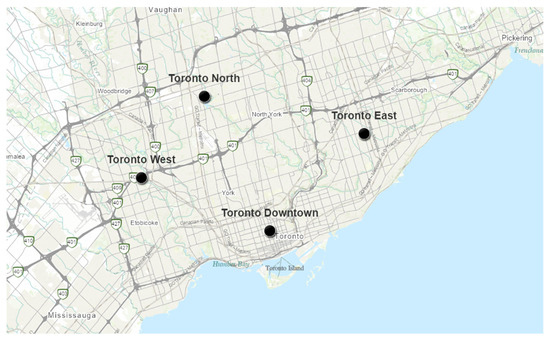
Figure 1.
Map of air quality measuring station locations within Toronto, Ontario, Canada. Toronto East (43.75° N, 79.27° W) and Toronto West (43.71° N, 79.54° W) were used in this study. Due to data issues, Toronto North and Toronto Downtown were not used in this analysis. The scale is 1:220,000.
2.2. Method
2.2.1. Climatology and Baseline
The climatological baseline was formed using aggregated measurements of NO, NO2, and ozone for the months of April to June for the baseline period, 2010–2019, a 10-year average of the same months for both stations, and binned by “weekend” and “weekday”. “Weekends” included each Saturday and Sunday, as well as holidays in the 3-month period (Easter Friday when it occurred in April, Victoria Day in May), following the methodology used in [10,26]. Weekdays were the average of Monday through Friday excluding the two holidays. Each hour was averaged over the 3 months and binned into weekday and weekend. These climatological means were graphed with the corresponding 2020 data.
2.2.2. Data Ranking
The year 2020 data were ranked out of 11 years (2010–2020) examined for the 3-month aggregate (April–June average) for each station, separately ranking the weekday and weekend data, with “1” indicating the highest values during the 11-year period and “11” indicating the lowest values during this period.
2.2.3. Fisher Exact Test
The data were examined to determine if 2020 deviated significantly from expectation. To do this, the Fisher’s exact test was used to determine if the number of records in a particular year was significantly different than expectation. This test is particularly applicable to cases with small, expected values rather than using the more familiar chi-squared test. Hourly aggregated data were examined over the 11-year period. If the data are randomly distributed, the expectation is that, for any given year, there will be on average 2.2 extremes per year, i.e., 24 hourly data records over the 11 years (24/11 = 2.2). According to the Fisher exact test, if the number of records in a given year is nine or more for a 24 h sample size, this is statistically significant with a p-value at the 0.05 level, while a number of 11 or more is statistically significant at the 0.01 p-value level. This test was used to explore the degree of exceptionalism of 2020 for the two locations and for the three air quality measures for each hour of the day.
3. Results
The data collected were used to evaluate the data from the 3-month period from April to June of 2020 against the baseline period from 2010 to 2019.
3.1. Baseline 2010–2019
Nitrous oxide (NO) concentrations (Figure 2) followed a distinct daily cycle with a considerably muted cycle on weekends compared to weekdays, consistent with patterns of vehicular traffic. The peak values coincided with the morning rush hour and were consistent with weekend/weekday ozone scavenging [10]. These emissions were greater at Toronto West than Toronto East, where there is substantially higher traffic volume. Thus, nitrous oxide is mainly gained through vehicular emissions during the rush hour. NO then reacts readily with ozone (Reaction (1)) to produce NO2 and O2 and reaches a steady state as regulated by Reactions (1)–(4).
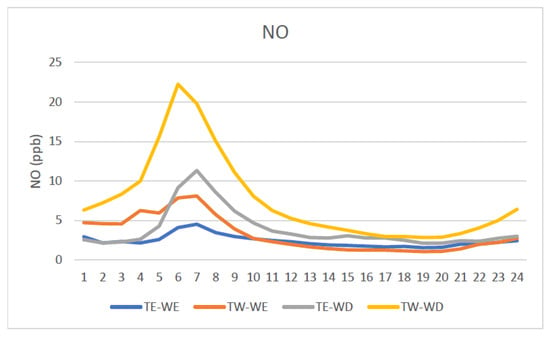
Figure 2.
Nitrous oxide concentration (ppb) during the baseline period (2010–2019) for Toronto West (TW) and Toronto East (TE) for weekends (WE) and weekdays (WD).
Nitrogen dioxide (NO2) concentrations (Figure 3), like nitrous oxide, had a distinctive peak during the morning rush hour that was clearly seen for weekdays (WD) and was largely absent for weekends (WE). The Toronto West results had a greater diurnal amplitude, substantially exceeding Toronto East during the morning rush hour, but lower values in the afternoon than those of Toronto East. In addition, at Toronto West, there was a late afternoon/early evening secondary peak, likely related to diminished photochemical activity (Reaction (2)), with the accumulation of NO2 and a coincident decrease in ozone (Figure 4). The difference between the two stations may be the result of varying concentrations of VOCs and consequent production of peroxy radicals, needed in the Reaction (3) chemistry. Given the more residential characteristic of the Toronto East site, this seems likely.
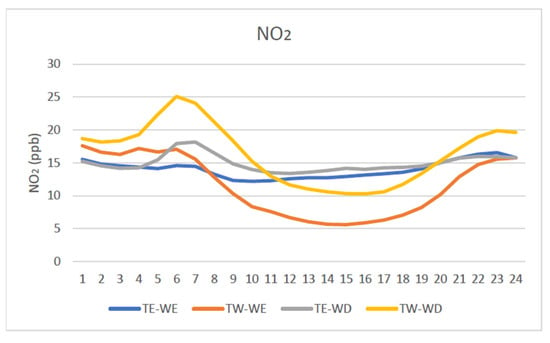
Figure 3.
Nitrogen dioxide concentration (ppb) during the baseline period (2010–2019) for Toronto West (TW) and Toronto East (TE) for weekends (WE) and weekdays (WD).
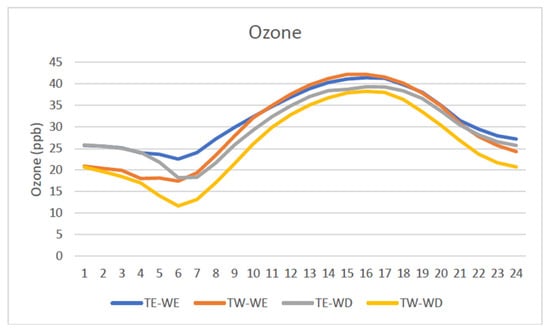
Figure 4.
Ozone concentration (ppb) during the baseline period (2010–2019) for Toronto West (TW) and Toronto East (TE) for weekends (WE) and weekdays (WD).
The ozone levels for the baseline period, 2010–1019, are consistent with previous work [10,26,36,61], clearly showing a distinct weekday/weekend effect with substantial higher values of ozone on weekends (Figure 4) [10,26,36,61]. For both Toronto East and Toronto West, the weekends had a distinctively muted early morning reduction in ozone attributed to the lack of substantial morning vehicular rush hour, with a coincident reduction in NO and NO2 emissions (Figure 2 and Figure 3). The Toronto West observation site, as noted above, is located near a major urban thoroughfare, whereas Toronto East is located in a suburban residential area.
3.2. 2020 Data
The aggregate data (April–June average) for the first wave during the 3-month period from April to June of 2020 are presented in Table 1, Table 2 and Table 3 for the baseline period (2010–2019) and 2020, for the two Toronto stations (East and West) and for the three air quality measures, NO and NO2, and ozone (O3), respectively. As shown in Table 1 and Table 2, NO and NO2 experienced substantial reductions during the 2020 pandemic first wave, by up to 70% below the baseline period. As observed in the previous section, the baseline values of NO and NO2 for TW were higher than TE, except for NO2 on weekends. Weekdays exceeded weekends for both stations for these two measures. While there was a ubiquitous reduction in NO emissions in 2020 (Table 1), this was amplified for Toronto East (TE) and for weekends, as measured by the percentage difference from the baseline period. Generally, NO2 (Table 2) followed this same pattern, although the relative reduction at TW was less than at TE. In a striking contrast, the changes in ozone concentration on weekends did not differ substantially from the baseline period (<2% difference), and, for weekdays, ozone concentrations increased by 10–15%, with the larger increase for TW. The increase in ozone while NO and NO2 decreased is consistent with other pandemic results [21,37,45,50], a point explored in greater detail in the hourly analysis.

Table 1.
The 3-month (April to June) aggregate results for NO for the baseline period (2010–2019) and 2020 and the percentage reduction for 2020 from the baseline period, analyzed for Toronto East (TE) and Toronto West (TW) for both weekends (WE) and weekdays (WD).

Table 2.
The 3-month (April to June) aggregate results for NO2 for the baseline period (2010–2019) and 2020 and the percentage reduction for 2020 from the baseline period, analyzed for Toronto East (TE) and Toronto West (TW) for both weekends (WE) and weekdays (WD).

Table 3.
The 3-month (April to June) aggregate results for O3 for the baseline period (2010–2019) and 2020 and the percentage reduction for 2020 from the baseline period, analyzed for Toronto East (TE) and Toronto West (TW) for both weekends (WE) and weekdays (WD).
Figure 5 and Figure 6 depict, for Toronto East and Toronto West, respectively, nitrous oxide, NO, for 2020 (WE 2020, WD 2020), relative to the baseline values (WE, WD). During the morning rush hour period (5–8 pm), there was a substantial reduction in NO detected during 2020 for both weekends and weekdays, with an amplified reduction for the weekdays (WD vs. WD 2020). The NO values were higher, and the reduction was greater at Toronto West. For all hours of the day, and for both weekends and weekdays, the weekday NO values were higher than weekend values, although differences between the two were smaller for 2020. These results are consistent with a reduction in vehicular traffic during the first wave of the pandemic in Ontario due to the mandated lockdown. The City of Toronto measures traffic congestion using a travel time index (TTI). In 2019, for the afternoon rush hour in spring, a value of 1.76 was typical, indicating travel times were slower by 76%; however, during the study period (March–June 2020), the TTI was 1.0, indicating no delays due to traffic congestion.
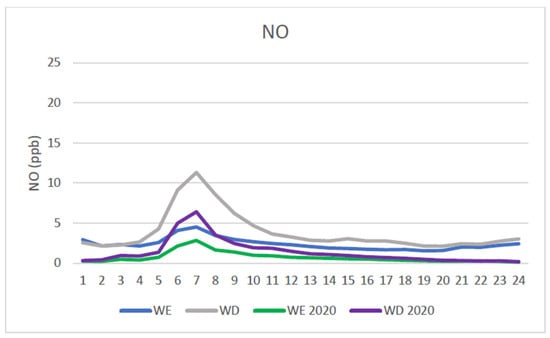
Figure 5.
Nitrous oxide (NO) for the average period April to June 2010–2019 for weekends (WE) and weekdays (WD) and for April to June 2020 (WE 2020, WD 2020) at Toronto East.
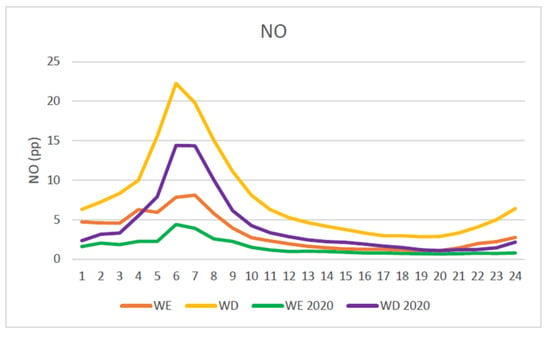
Figure 6.
Nitrous oxide (NO) for the average period April to June 2010–2019 for weekends (WE) and weekdays (WD) and for April to June 2020 (WE 2020, WD 2020) at Toronto West.
Figure 7 and Figure 8 depict, for Toronto East and Toronto West, respectively, nitrogen dioxide, NO2, for 2020 (WE 2020, WD 2020), relative to the baseline values (WE, WD), the most distinct difference of the three air quality measures examined. For the entire day, there was a substantial reduction in NO2 detected during 2020 for both weekends and weekdays, a difference that peaked in the afternoon unlike the NO results, particularly notable at Toronto East. The diurnal amplitude of 2020 NO2 was similar to that experienced during the baseline NO2 behavior at Toronto West, suggesting that a muted VOC reduction relative to NOx was more important for Toronto East during 2020, These results are consistent with a reduction in vehicular traffic in a NOx-saturated environment during the first wave of the pandemic in Ontario due to the mandated lockdown.
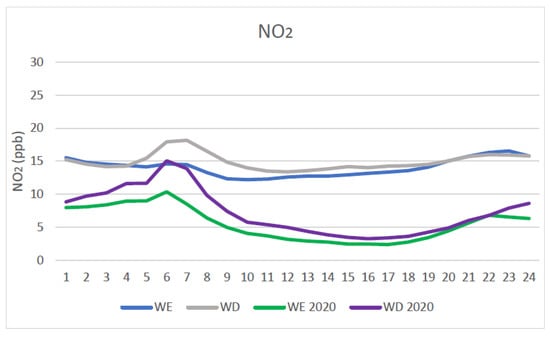
Figure 7.
Nitrogen dioxide (NO2) for the average period April to June 2010–2019 for weekends (WE) and weekdays (WD) and for April to June 2020 (WE 2020, WD 2020) at Toronto East.
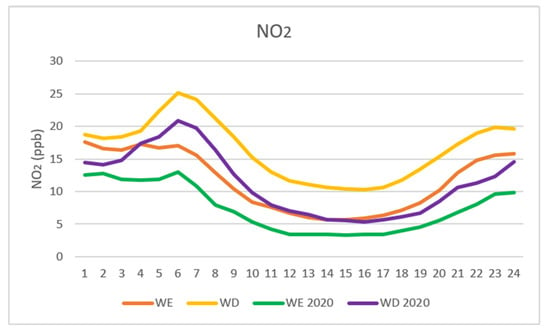
Figure 8.
Nitrogen dioxide (NO2) for the average period April to June 2010–2019 for weekends (WE) and weekdays (WD) and for April to June 2020 (WE 2020, WD 2020) at Toronto West.
Figure 9 and Figure 10 depict the ozone levels for Toronto East and Toronto West, respectively, for 2020 (WE 2020, WD 2020), relative to the baseline values (WE, WD). During the morning rush hour period (5:00–8:00 a.m.), the weekend values (WE, WE 2020) did not differ significantly, with WE 2020 being marginally higher at Toronto East and higher at Toronto Wet. However, for the weekdays at both locations, the minimum ozone concentration was lower for the baseline period (WD) compared to 2020 (WD 2020). The muted morning rush hour during the first wave of the pandemic (due to the sanctioned lockdown) resulted in a muted ozone response, likely the result of reduced scavenging by NO (Reaction (1)). Weekend values remained higher for the baseline results compared to weekday values throughout the day, but this was not observed for 2020. By afternoon, in 2020, the weekday values exceeded those of the weekend. This was observed at both locations, although the difference was greater at Toronto East. This was likely the result of NOx reduction relative to VOC reduction in a NOx-saturated environment, generating more ozone [13,18], suggesting that any reduction in VOCs was less intense than the reduction in NOx.
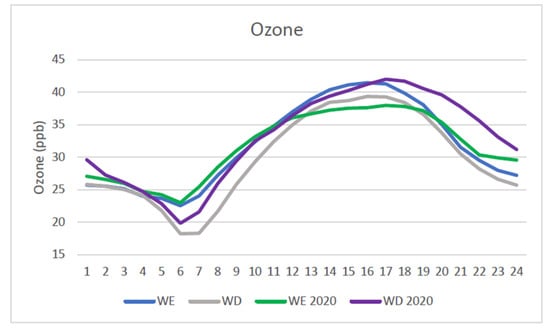
Figure 9.
Ground-level ozone (O3) for the average period April to June 2010–2019 for weekends (WE) and weekdays (WD) and for April to June 2020 (WE 2020, WD 2020) at Toronto East.
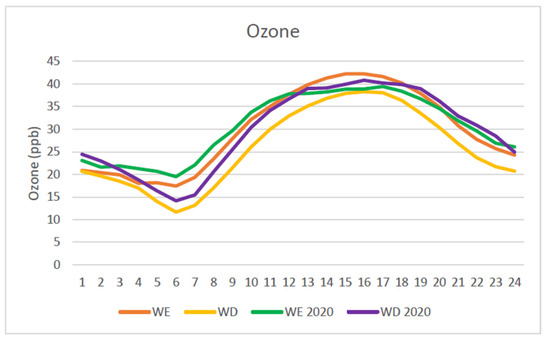
Figure 10.
Ground-level ozone (O3) for the average period April to June 2010–2019 for weekends (WE) and weekdays (WD) and for April to June 2020 (WE 2020, WD 2020) at Toronto West.
3.3. Ranking Analysis
The 2020 aggregate values (over the April to June period) of the air pollution measures (NO, NO2, O3) were ranked within the 11-year record (2010–2020) for the two Toronto stations (Toronto West, Toronto East), with “1” indicating the highest values during the 11-year period and “11” indicating the lowest values during this period. This was done for weekdays (WD) and weekends (WE), and the results are presented in Table 4 and Table 5, respectively. A clear signal emerged with NO and NO2 values being the lowest for both locations independent of weekday and weekend. This is consistent with the substantial reduction in vehicular traffic during the first lockdown of the COVID pandemic and Adams (2020), as well as with other COVID-19 pandemic analyses [21,37,45,46,50].

Table 4.
Ranking of 2020 with the period of 2010–2020 with 1 for the highest value and 11 for the lowest value for the two Toronto stations, Toronto East (TE) and Toronto West (TW) for weekdays.

Table 5.
Ranking of 2020 with the period of 2010–2020 with 1 for the highest value and 11 for the lowest value for the two Toronto stations, Toronto East (TE) and Toronto West (TW) for weekends.
The ozone results were more nuanced. For weekdays, the 2020 ozone concentrations were the highest for Toronto East and Toronto West. The ozone results for the weekend, however, were unremarkable, landing in the middle of the 11 years at rankings of 6 for both Toronto East and Toronto West. These results are consistent with a NOx-dominated atmosphere [10,13,18]. On weekdays during the pandemic lockdown, as shown in the previous section, there was a substantial reduction in NO and NO2, especially notable during the morning rush hour (Figure 7, Figure 8, Figure 9 and Figure 10). Thus, the weekday mechanism for scavenging ozone was mitigated, allowing ozone concentrations to be higher (Figure 5 and Figure 6). On the weekend, the difference in NO concentrations in the early morning was lower than the average over the previous 10 years but the difference was less than observed for weekdays (Figure 7 and Figure 8). This resulted in weekend ozone concentrations that were not substantially different from non-pandemic years (<2% difference). Combining these results, the ozone weekend effect while still apparent was muted (Figure 5 and Figure 6) during the morning rush hour (5:00–8:00 a.m.). By mid-afternoon, during the climatological period (2010–2019), ozone concentrations on weekends were higher but this reversed for the pandemic year (2020) with weekday concentrations exceeding weekends, particularly in the late afternoon. As noted above, this a clear indication of a NOx-saturated environment with greater NOx reduction relatively to VOC reduction, leading to greater ozone concentrations, a phenomenon observed in other parts of the world [50].
3.4. Fisher’s Exact Test
The Fisher’s Exact test allows the expansion of the analysis of the previous ranking exercise by examining hourly data. In the dataset, there were 24 h of daily data for three stations divided into two bins, weekend and weekday. This test allowed the examination of extreme values for each year. If the data are evenly distributed over the 11 years (that is, no net trends and no outlier years), the expectation is for 2.2 extremes per year (24/11), i.e., of the 24 h worth of annual averaged data (April to June), 2.2 h on average over the 11 years would be records. These extremes per year were tabulated by location, air pollution element, and weekday/weekend binning. Fisher’s exact test for this sample size indicated that any values 9 or more were significant at p < 0.05, and any values 11 or more were significant at p < 0.01. Table 6 and Table 7 present the results of this analysis for weekdays and weekends, respectively. These results confirm statistically that 2020 was an exceptionally low year for NO and NO2. It was an exceptionally high year for ozone during the weekdays but not exceptional for ozone on weekends.

Table 6.
The number of extreme values out of 24 in 2020 using averaged hourly data from April to June for weekdays. p-Values < 0.01 for 11 or more are shown in bold. The extremes for ozone are maximum values; the extremes for NO and NO2 are minimum values.

Table 7.
The number of extreme values out of 24 in 2020 using averaged hourly data from April to June for weekends. p-Values < 0.05 for 9 or more and p-values < 0.01 for 11 or more are both shown in bold. The extremes for ozone are maximum values; the extremes for NO and NO2 are minimum values.
4. Discussion
The COVID-19 pandemic and its impact on human activity, including human health, have provided an unprecedented opportunity to explore the impact on anthropogenic air quality chemistry. Other recent work has reported a substantial reduction for most air pollutants such as NOx, but an unambiguous signal for ground-level tropospheric ozone, a secondary pollutant generated by photochemistry in the presence of chemical precursors (NOx, VOCs) and ultraviolet radiation [21,36,37,38,39,40,41,42,43,44,45,46,47,48,49,50].
In this work, the impact during the first wave of the pandemic (April to June of 2020) was examined in detail for Toronto, Ontario, Canada building on previous ozone weekend effect work [10,26,61,62]. This earlier work established a well-developed weekday/weekend ozone effect in the Toronto area that yielded higher ozone levels on the weekend due to the mitigated weekend rush hour and resultant reduction in ozone scavenging by nitrous oxide.
Data from two representative observing stations in the Toronto area were used, Toronto East and Toronto West. Consistent with other locations around the world, NO and NO2 were substantially reduced as a result of a local lockdown during the first wave, with as much as a 69% reduction at Toronto West. This percentage reduction was greater for weekends than weekdays and greater for NO than NO2. The two stations had qualitatively similar results, although Toronto West values were of higher magnitude due to closer proximity to major transportation infrastructure. Two ranking exercises provided clear indications of the exceptionalism of the 2020 NO and NO2 data compared to the previous 10 years (2010–2019) demonstrating that that 2020 was an outlier. Fisher’s exact test on the hourly data confirmed the aggregate data ranking at a high level of statistical significance (p < 0.01).
In striking contrast, ground=level tropospheric ozone did not exhibit this clear behavior observed in the two primary pollutants. The weekend/weekday effect, as more clearly detected during the 5:00–8:00 a.m. time frame, remained present but was muted compared to the baseline period. Overall, on weekends, ozone concentrations were not substantially different during the first wave of the pandemic, and ozone concentrations were higher, by up to 15%, during weekdays; thus, a net reduction in the hebdomadal weekday/weekend difference for Toronto West and an unprecedented reversal for Toronto East were observed, in which weekday averages exceeded those of weekends in 2020. This somewhat counterintuitive impact on ozone (an increase rather than a decrease) is consistent with the ozone chemistry of the weekend/weekday effect and an indicator, similar to other locations around the world [50], that Toronto exists in a NOx-saturated environment (with respect to VOCs). Ozone reductions do not occur in such an environment unless VOCs are reduced at a greater rate than NOx reductions. This is consistent with the conclusion of [10], which indicated a local NOx-saturated environment for Toronto. This has clear implications for ozone abatement strategies and indicates the futility of targeting NOx reduction without simultaneously considering concurrent VOC reduction.
5. Conclusions
The COVID-19 pandemic and its impact on human activity have provided a unique opportunity to observe the resulting anthropogenic air quality chemistry. Other work indicated a clear reduction in most air pollutants, but not a clear signal for ground-level tropospheric ozone. The impact during the first wave of the pandemic (April to June of 2020) was examined in detail for Toronto, Ontario, Canada building on previous ozone weekend effect work [10,26,61,62]. Data from two representative observing stations in the Toronto area were used. Consistent with other locations around the world, NO and NO2 were substantially reduced as a result of a local lockdown during the first wave, with as much as a 69% reduction. The percentage reduction was greater for weekends than weekdays and greater for NO than NO2. Two ranking exercises on the NO and NO2 data indicated the exceptionalism of the 2020 data compared to the previous 10 years (2010–2019), demonstrating that 2020 was a clear outlier. In contrast, ground-level tropospheric ozone did not exhibit this clear behavior. On weekends, ozone concentrations were not substantially different during the first wave of the pandemic, and ozone concentrations were higher, by over 10%, during weekdays, weakening the ozone weekend effect. This somewhat counterintuitive result is consistent with the ozone chemistry of the weekend/weekday effect and an indicator, as in other locations around the world, that Toronto, Ontario exists in a NOx-saturated environment (with respect to VOCs), and that ozone reductions do not occur in such an environment unless VOCs are reduced at a greater rate than NOx. This has clear implications for ozone abatement strategies.
Author Contributions
Conceptualization, W.A.G. and V.A.; methodology, W.A.G.; resources, W.A.G.; data curation, W.A.G.; writing—original draft preparation, W.A.G.; writing—review and editing, V.A. and W.A.G. All authors have read and agreed to the published version of the manuscript.
Funding
The authors are supported by W.A.G.’s Natural Sciences and Engineering Research Council of Canada (NSERC) Grant RGPIN-2018-06801.
Institutional Review Board Statement
Not applicable.
Informed Consent Statement
Not applicable.
Data Availability Statement
Not applicable.
Conflicts of Interest
The authors declare no conflict of interest.
References
- Menut, L.; Bessagnet, B.; Siour, G.; Mailler, S.; Pennel, R.; Cholakian, A. Impact of lockdown measures to combat Covid-19 on air quality over western Europe. Sci. Total Environ. 2020, 741, 140426. [Google Scholar] [CrossRef] [PubMed]
- Shi, X.; Brasseur, G.P. The response in air quality to the reduction of Chinese economic activities during the COVID-19 outbreak. Geophys. Res. Lett. 2020, 47, e2020GL088070. [Google Scholar] [CrossRef] [PubMed]
- Dutheil, F.; Baker, J.S.; Navel, V. COVID-19 as a factor influencing air pollution? Environ. Pollut. 2020, 263, 114466. [Google Scholar] [CrossRef] [PubMed]
- Bao, R.; Zhang, A. Does lockdown reduce air pollution? Evidence from 44 cities in northern China. Sci. Total Environ. 2020, 731, 139052. [Google Scholar] [CrossRef]
- Krecl, P.; Targino, A.C.; Oukawa, G.Y.; Cassino Junior, R.P. Drop in urban air pollution from COVID-19 pandemic: Policy implications for the megacity of São Paulo. Environ. Pollut. 2020, 265, 114883. [Google Scholar] [CrossRef] [PubMed]
- Rodríguez-Urrego, D.; Rodríguez-Urrego, L. Air quality during the COVID-19: PM2.5 analysis in the 50 most polluted capital cities in the world. Environ. Pollut. 2020, 266, 115042. [Google Scholar] [CrossRef]
- Kerimray, A.; Baimatova, N.; Ibragimova, O.P.; Bukenov, B.; Kenessov, B.; Plotitsyn, P.; Karaca, F. Assessing air quality changes in large cities during COVID-19 lockdowns: The impacts of traffic-free urban conditions in Almaty, Kazakhstan. Sci. Total Environ. 2020, 730, 139179. [Google Scholar] [CrossRef]
- Li, L.; Li, Q.; Huang, L.; Wang, Q.; Zhu, A.; Xu, J.; Liu, Z.; Li, H.; Shi, L.; Li, R.; et al. Air quality changes during the COVID-19 lockdown over the Yangtze River Delta Region: An insight into the impact of human activity pattern changes on air pollution variation. Sci. Total Environ. 2020, 732, 139282. [Google Scholar] [CrossRef]
- Burnett, R.T.; Brook, J.R.; Yung, W.T.; Dales, R.E.; Krewski, D. Association between ozone and hospitalization for respiratory diseases in 16 Canadian cities. Environ. Res. 1997, 72, 24–31. [Google Scholar] [CrossRef]
- Huryn, S.M.; Gough, W.A. Impact of urbanization on the ozone weekday/weekend effect in Southern Ontario, Canada. Urban Clim. 2014, 8, 11–20. [Google Scholar] [CrossRef]
- Murphy, J.G.; Day, D.A.; Cleary, P.A.; Wooldridge, P.J.; Millet, D.B.; Goldstein, A.H.; Cohen, R.C. The weekend effect within and downwind of Sacramento: Part 1. Observations of ozone, nitrogen oxides and VOC reactivity. Atmos. Chem. Phys. Discuss. 2006, 6, 11427–11464. [Google Scholar] [CrossRef]
- Murphy, J.G.; Day, D.A.; Cleary, P.A.; Wooldridge, P.J.; Millet, D.B.; Goldstein, A.H.; Cohen, R.C. The weekend effect within and downwind of Sacramento: Part 2. Observational evidence for chemical and dynamical contributions. Atmos. Chem. Phys. Discuss. 2006, 6, 11971–12019. [Google Scholar]
- Geddes, J.A.; Murphy, J.G.; Wang, D.K. Long term changes in nitrogen oxides and volatile organic compounds in Toronto and the challenges facing local ozone control. Atmos. Environ. 2009, 43, 3407–3415. [Google Scholar] [CrossRef]
- Beekmann, M.; Vautard, R. A modelling study of photochemical regimes over Europe: Robustness and variability. Atmos. Chem. Phys. 2010, 10, 10067–10084. [Google Scholar] [CrossRef]
- Pusede, S.E.; Cohen, R.C. On the observed response of ozone to NOx and VOC reactivity reductions in San Joaquin Valley California 1995-present. Atmos. Chem. Phys. 2012, 12, 8323–8339. [Google Scholar] [CrossRef]
- Markakis, K.; Valari, M.; Colette, A.; Sanchez, O.; Perrussel, O.; Honore, C.; Vautard, R.; Klimont, Z.; Rao, S. Air-quality in the mid-21st century for the city of Paris under two climate scenarios; from regional to local scale. Atmos. Chem. Phys. 2014, 14, 95–136. [Google Scholar] [CrossRef][Green Version]
- Karl, T.; Graus, M.; Striednig, M.; Lamprecht, C.; Hammerle, A.; Wohlfahrt, G.; Held, A.; von der Heyden, L.; Deventer, M.J.; Krismer, A.; et al. Urban eddy covariance measurements reveal significant missing NOx emissions in Central Europe. Sci. Rep. 2017, 7, 2536. [Google Scholar] [CrossRef] [PubMed]
- Sicard, P.; Paoletti, E.; Agathokleous, E.; Araminiene, V.; Proietti, C.; Coulibaly, F.; DeMarco, A. Ozone weekend effect in cities: Deep insights for urban air pollution control. Environ. Res. 2020, 191, 110193. [Google Scholar] [CrossRef]
- Tang, G.; Wang, Y.; Li, X.; Ji, D.; Hsu, S.; Gao, X. Spatial-temporal variations in surface ozone in Northern China as observed during 2009–2010 and possible implications for future air quality control strategies. Atmos. Chem. Phys. 2012, 12, 2757–2776. [Google Scholar] [CrossRef]
- Xue, L.K.; Wang, T.; Gao, J.; Ding, A.J.; Zhou, X.H.; Blake, D.R.; Wang, X.F.; Saunders, S.M.; Fan, S.J.; Zuo, H.C.; et al. Ground-level ozone in four Chinese cities: Precursors, regional transport and heterogeneous processes. Atmos. Chem. Phys. 2014, 14, 13175–13188. [Google Scholar] [CrossRef]
- Brancher, M. Increased ozone pollution alongside reduced nitrogen dioxide concentrations during Vienna’s first COVID-19 lockdown: Significance for air quality management. Environ. Pollut. 2021, 284, 117193. [Google Scholar] [CrossRef] [PubMed]
- Cleveland, W.S.; Graedel, T.E.; Kleiner, B.; Warmer, J.L. Sunday and workday variations in the photochemical air pollution in New Jersey and New York. Science 1974, 186, 1037–1038. [Google Scholar] [CrossRef] [PubMed]
- Lebron, F. A comparison of weekend weekday ozone and hydrocarbon concentrations in the Baltimore Washington Metropolitan Area. Atmos. Environ. 1975, 9, 861–863. [Google Scholar] [CrossRef]
- Elkus, B.; Wilson, K.R. Photochemical air pollution: Weekend–weekday differences. Atmos. Environ. 1977, 11, 509–515. [Google Scholar] [CrossRef]
- Karl, T.R. Day of the week variations of photochemical pollutants in the St. Louis area. Atmos. Environ. 1978, 12, 1657–1667. [Google Scholar] [CrossRef]
- Beaney, G.; Gough, W.A. The influence of tropospheric ozone on the air temperature of the city of Toronto, Ontario, Canada. Atmos. Environ. 2002, 36, 2319–2325. [Google Scholar] [CrossRef]
- Sadanaga, Y.; Shibata, S.; Hamana, M.; Takenaka, N.; Bandow, H. Weekday/weekend differences of ozone and its precursors in urban areas of Japan, focusing on nitrogen oxides and hydrocarbons. Atmos. Environ. 2008, 42, 4708–4723. [Google Scholar] [CrossRef]
- Pudasainee, D.; Sapkota, B.; Bhatnagar, A.; Kim, S.H.; Seo, Y.C. Influence of weekdays, weekends, and bandhas on surface ozone in Kathmandu valley. Atmos. Res. 2010, 95, 150–156. [Google Scholar] [CrossRef]
- Pires, M. Ozone weekend effect analysis in three European urban areas. CLEAN-Soil Air Water 2012, 40, 790–797. [Google Scholar] [CrossRef]
- Castell-Balaguer, N.; Téllez, L.; Mantilla, E. Daily, seasonal and monthly variations in ozone levels recorded at the Turia river basin in Valencia (Eastern Spain). Environ. Sci. Pollut. Res. 2012, 19, 3461–3480. [Google Scholar] [CrossRef]
- Im, U.; Incecik, S.; Guler, M.; Tek, A.; Topcu, S.; Unal, Y.S.; Yenigun, O.; Kindap, T.; Odman, M.T.; Tayanç, M. Analysis of surface ozone and nitrogen oxides at urban, semi-rural and rural sites in Istanbul, Turkey. Sci. Total Environ. 2013, 443, 920–931. [Google Scholar] [CrossRef] [PubMed]
- Wolf, G.T.; Kalhbaum, D.F.; Heuss, J.M. The vanishing ozone weekday/weekend effect. J. Air Waste Manag. Assoc. 2013, 63, 292–299. [Google Scholar] [CrossRef] [PubMed]
- Wang, Z.S.; Li, Y.T.; Chen, T.; Zhang, D.W.; Sun, F.; Sun, R.W.; Dong, X.; Sun, N.D.; Pan, L.B. Temporal and spatial distribution characteristics of ozone in Beijing. Huan Jing Ke Xue 2014, 35, 4446–4453. [Google Scholar] [PubMed]
- Szep, R.; Matyas, L.; Keresztes, R.; Ghimpusan, M. Tropospheric ozone concentrations-seasonal and daily analysis and its association with NO and NO2 as a function of NOx in Ciuc depression—Romania. Rev. Chim. 2016, 67, 205–213. [Google Scholar]
- Yao, X.; Lau, N.T.; Chan, C.K.; Fang, M. The use of tunnel concentration profile data to determine the ratio of NO2/NOx directly emitted from vehicles. Atmos. Chem. Phys. Discuss. 2005, 5, 12723–12740. [Google Scholar]
- Adams, M.D. Air pollution in Ontario, Canada during the COVID-19 state of emergency. Sci. Total Environ. 2020, 742, 140516. [Google Scholar] [CrossRef] [PubMed]
- Adam, M.G.; Tran, P.T.M.; Balasubramanian, R. Air quality changes in cities during the COVID-19 lockdown: A critical review. Atmos. Res. 2021, 264, 105823. [Google Scholar] [CrossRef] [PubMed]
- Dantas, G.; Siciliano, B.; França, B.B.; da Silva, C.M.; Arbilla, G. The impact of COVID-19 partial lockdown on the air quality of the city of Rio de Janeiro, Brazil. Sci. Total Environ. 2020, 729, 139085. [Google Scholar] [CrossRef]
- Grange, S.K.; Lee, J.D.; Drysdale, W.S.; Lewis, A.C.; Hueglin, C.; Emmenegger, L.; Carslaw, D.C. COVID-19 lockdowns highlight a risk of increasing ozone pollution in European urban areas. Atmos. Chem. Phys. 2021, 21, 4169–4185. [Google Scholar] [CrossRef]
- Keller, C.A.; Evans, M.J.; Knowland, K.E.; Hasenkopf, C.A.; Modekurty, S.; Lucchesi, R.A.; Oda, T.; Franca, B.B.; Mandarino, F.C.; Díaz Suarez, M.V.; et al. Global impact of COVID-19 restrictions on the atmospheric concentrations of nitrogen dioxide and ozone. Atmos. Chem. Phys. 2021, 21, 3555–3592. [Google Scholar] [CrossRef]
- Lovri, M.; Pavlovi, K.; Vukovi, M.; Grange, S.K.; Haberl, M.; Kern, R. Understanding the true effects of the COVID-19 lockdown on air pollution by means of machine learning. Environ. Pollut. 2021, 274, 115900. [Google Scholar] [CrossRef]
- Luo, J.; Qin, G.; Cheng, J. Ozone pollution mitigation in Guangxi (south China) driven by meteorology and anthropogenic emissions during the COVID-19. Environ. Pollut. 2020, 272, 115927. [Google Scholar] [CrossRef]
- Miyazaki, K.; Bowman, K.; Sekiya, T.; Jiang, Z.; Chen, X.; Eskes, H.; Ru, M.; Zhang, Y.; Shindell, D. Air quality response in China linked to the 2019 novel Coronavirus (COVID-19) lockdown. Geophys. Res. Lett. 2020, 47, e2020GL089252. [Google Scholar] [CrossRef] [PubMed]
- Ordonez, C.; Garrido-Perez, J.M.; García-Herrera, R. Early spring near-surface ozone in Europe during the COVID-19 shutdown: Meteorological effects outweigh emission changes. Sci. Total Environ. 2020, 747, 141322. [Google Scholar] [CrossRef] [PubMed]
- Qi, J.; Mo, Z.; Yuan, B.; Huang, S.; Huangfu, Y.; Wang, Z.; Li, X.; Yang, S.; Wang, W.; Zhao, Y.; et al. An observation approach in evaluation of ozone production to precursor changes during the COVID-19 lockdown. Atmos. Environ. 2021, 262, 118618. [Google Scholar] [CrossRef] [PubMed]
- Sicard, P.; De Marco, A.; Agathokleous, E.; Feng, Z.; Xu, X.; Paoletti, E.; Rodriguez, J.J.D.; Calatayud, V. Amplified ozone pollution in cities during the COVID-19 lockdown. Sci. Total Environ. 2020, 735, 139542. [Google Scholar] [CrossRef]
- Siciliano, B.; Dantas, G.; Cleyton, M.; Arbilla, G. Increased ozone levels during the COVID-19 lockdown: Analysis for the city of Rio de Janeiro, Brazil. Sci. Total Environ. 2020, 737, 139765. [Google Scholar] [CrossRef]
- Singh, V.; Singh, S.; Biswal, A.; Kesarkar, A.P.; Mor, S.; Ravindra, K. Diurnal and temporal changes in air pollution during COVID-19 strict lockdown over different regions of India. Environ. Pollut. 2020, 266, 115368. [Google Scholar] [CrossRef]
- Soni, M.; Ojha, N.; Girach, I. Impact of COVID-19 lockdown on surface ozone build-up at an urban site in western India based on photochemical box modelling. Curr. Sci. 2021, 120, 376–381. [Google Scholar] [CrossRef]
- Trebrewal, K.; Venkataraman, C. COVID-19 lockdown closures of emissions sources in India: Lessons for air quality and climate policy. J. Environ. Manag. 2022, 302, 114079. [Google Scholar] [CrossRef]
- Conticini, E.; Frediani, B.; Caro, D. Can atmospheric pollution be considered a co-factor in extremely high level of SARS-CoV-2 lethality in Northern Italy? Environ. Pollut. 2020, 261, 114465. [Google Scholar] [CrossRef] [PubMed]
- Fattorini, D.; Regoli, F. Role of the chronic air pollution levels in the Covid-19 outbreak risk in Italy. Environ. Pollut. 2020, 264, 114732. [Google Scholar] [CrossRef] [PubMed]
- Delnevo, G.; Mirri, S.; Roccetti, M. Particulate matter and COVID-19 disease diffusion in Emilia-Romagna (Italy). Already a cold case? Computation 2020, 8, 59. [Google Scholar] [CrossRef]
- Zhu, Y.; Xie, J.; Huang, F.; Cao, L. Association between short-term exposure to air pollution and COVID-19 infection: Evidence from China. Sci. Total Environ. 2020, 727, 138704. [Google Scholar] [CrossRef]
- Brauer, M.; Reynolds, C.; Hystad, P. Traffic-related air pollution and health in Canada. CMAJ 2013, 185, 1557–1558. [Google Scholar] [CrossRef]
- Follinsbee, L.J. Human Health Effects of Air Pollution. Environ. Health Perspect. 1992, 100, 45–56. [Google Scholar] [CrossRef]
- Lippmann, M. Health Effects of Ozone: A Critical Review. JAPCA 1989, 39, 672–695. [Google Scholar] [CrossRef]
- Health Canada. Health Impacts of Air Pollution in Canada: Estimates of Premature Deaths and Nonfatal Outcomes—2021 Report. ISBN 978-0-660-37331-7. Available online: https://www.canada.ca/en/health-canada/services/publications/healthy-living/2021-health-effects-indoor-air-pollution.html (accessed on 20 January 2022).
- Kampa, M.; Castanas, E. Human health effects of air pollution. Environ. Pollut. 2008, 151, 362–367. [Google Scholar] [CrossRef]
- Nuvolone, D.; Petri, D.; Voller, F. The effects of ozone on human health. Environ. Sci. Pollut. Res. 2018, 25, 8074–8088. [Google Scholar] [CrossRef]
- Kumar, A.; Gough, W.; Yap, D. Weekend/weekday effect for tropospheric ozone events in Ontario, Canada. CMOS Bull. 1999, 27, 3–7. [Google Scholar]
- Leung, K.H.Y.; Arnillas, C.A.; Cheng, V.Y.S.; Gough, W.A.; Arhonditsis, G.B. Seasonality patterns and distinctive signature of latitude and population on ozone concentrations in Southern Ontario, Canada. Atmos. Environ. 2021, 246, 118077. [Google Scholar] [CrossRef]
Publisher’s Note: MDPI stays neutral with regard to jurisdictional claims in published maps and institutional affiliations. |
© 2022 by the authors. Licensee MDPI, Basel, Switzerland. This article is an open access article distributed under the terms and conditions of the Creative Commons Attribution (CC BY) license (https://creativecommons.org/licenses/by/4.0/).